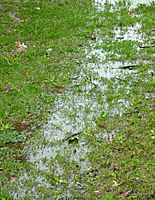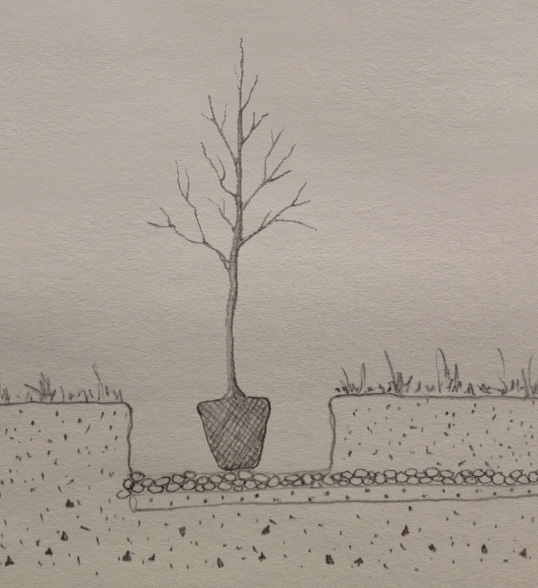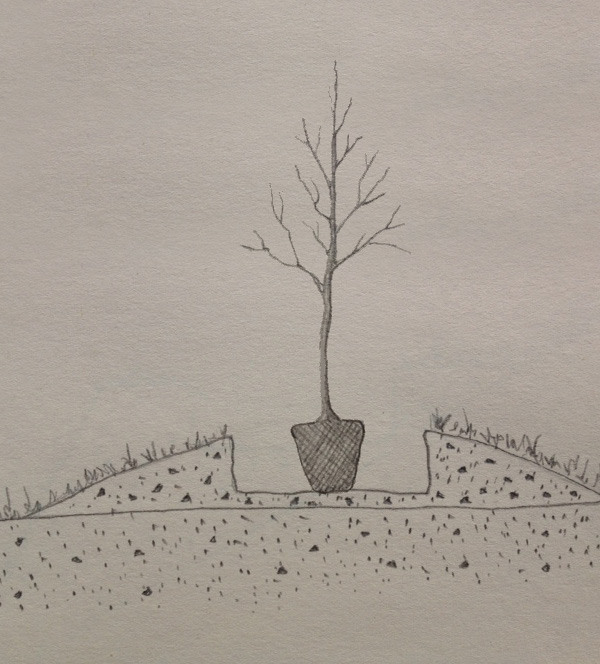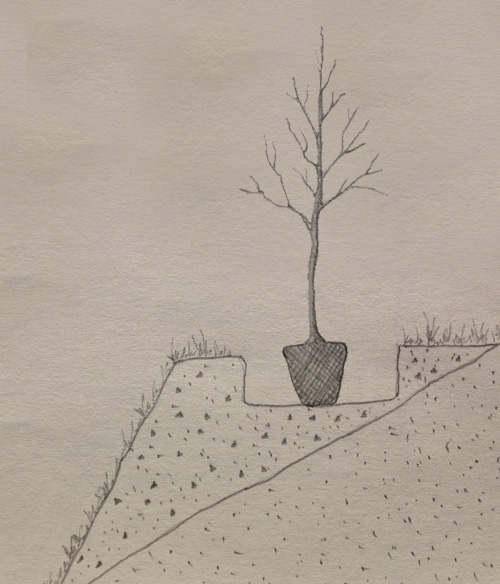 Naturally wet or clay soils can have a severe problem with drainage and planting most trees or shrubs in these locations will usually result in the plant dying unless it’s a variety that naturally lives in wet conditions, e.g. Bald Cypress or Pussy Willow. Plant roots require air and when they’re deprived of it the plant will drown. If your planting site has standing water any time of the year, use the test described below to determine the severity of your soil wetness. If the test identifies your soil as to wet for plants to survive, use one or more of the drainage practices described to improve the condition of the planting site.
Naturally wet or clay soils can have a severe problem with drainage and planting most trees or shrubs in these locations will usually result in the plant dying unless it’s a variety that naturally lives in wet conditions, e.g. Bald Cypress or Pussy Willow. Plant roots require air and when they’re deprived of it the plant will drown. If your planting site has standing water any time of the year, use the test described below to determine the severity of your soil wetness. If the test identifies your soil as to wet for plants to survive, use one or more of the drainage practices described to improve the condition of the planting site.
The first step in planting trees and shrubs in wet or clay soil is to determine how severe the problem is at the location where the planting will be done. You can determine the percolation rate of the soil by excavating a hole 30 inches wide by 30 inches deep. Fill the hole with water, let it drain completely, then fill it again. The second filling should drain at a rate of one inch (or more) per hour; in approximately a day-and-a-half, the water should be gone. If the water is indeed gone after this time, the drainage at this location should not be a problem for most trees and shrubs. If the hole has any water in the bottom, you must do one or more of the following drainage practices so the trees or shrubs will live after planting.
Excavate planting pits so they are large enough to accommodate the slow percolation rate. This practice can only be effective if the percolation rate is not severe. It provides more surface area for the water to drain from the planting pit and requires a minimum amount of work to provide acceptable drainage conditions for the newly planted trees or shrubs. A rough rule of thumb in determining the size of planting pit needed to provide adequate drainage is to double its diameter if the water is one-inch or less in the hole after the day-and-a half percolation test.
 Remove excess water from the bottom of the planting pits and direct it to a lower elevation by using French drains or perforated plastic (PVC or ABS) pipe. When drainage conditions are poor this is an excellent way of providing adequate drainage and good long-term growing conditions for the trees or shrubs. It’s effective for planting one tree or a large number of them by routing the drain through all the planting pits. Using French drains or perforated pipe has the advantage of eliminating wet soil conditions over a large area when the topography of the site allows water to be eliminated at a lower elevation. The drains need to drop at least six inches per hundred feet to adequately carry the water off. It’s also important to have a suitable discharge area for the pipe or you could easily create new wet conditions where water exits the drain.
Remove excess water from the bottom of the planting pits and direct it to a lower elevation by using French drains or perforated plastic (PVC or ABS) pipe. When drainage conditions are poor this is an excellent way of providing adequate drainage and good long-term growing conditions for the trees or shrubs. It’s effective for planting one tree or a large number of them by routing the drain through all the planting pits. Using French drains or perforated pipe has the advantage of eliminating wet soil conditions over a large area when the topography of the site allows water to be eliminated at a lower elevation. The drains need to drop at least six inches per hundred feet to adequately carry the water off. It’s also important to have a suitable discharge area for the pipe or you could easily create new wet conditions where water exits the drain.
 Build a raised planting area above the existing wet soil. This is without question one of the easiest ways to solve a wet soil problem and it works equally well for a large bed or a single planting. This method simply raises the level of the ground with well drained soil, than planting is done in the new layer above the original poorly drained soil. This method has the advantage of providing both improved drainage and better soil for planting. As with all of these drainage practices the topography must be conducive to draining the runoff from the new planting bed or you will simply be increasing or creating another wet area
Build a raised planting area above the existing wet soil. This is without question one of the easiest ways to solve a wet soil problem and it works equally well for a large bed or a single planting. This method simply raises the level of the ground with well drained soil, than planting is done in the new layer above the original poorly drained soil. This method has the advantage of providing both improved drainage and better soil for planting. As with all of these drainage practices the topography must be conducive to draining the runoff from the new planting bed or you will simply be increasing or creating another wet area
Excavate to a depth where the porosity of the soil will permit free draining. In many cases the wet soil condition is the result of an impervious clay layer that prevents drainage. In such cases the area will drain if you dig down through the clay soil to the more pervious subsoil. If this condition exists in the planting area all that’s required is to break through the impervious layer and the top soil will drain. In many cases this type of drainage problem will not show up when doing the percolation test because the bottom of the 30-inch hole is below the impervious layer.
 Terrace the land if there is a difference in elevation. Another technique to promote good drainage is to build terraces using soil that is amended or well drained. This technique is very similar to constructing raised planting beds except it’s done on slopping land. As with the raised bed technique it has the advantage of improving the soil during construction. If the terraces are narrow, however, it has the disadvantage of having soil that is to well drained and warm during the summer months.
Terrace the land if there is a difference in elevation. Another technique to promote good drainage is to build terraces using soil that is amended or well drained. This technique is very similar to constructing raised planting beds except it’s done on slopping land. As with the raised bed technique it has the advantage of improving the soil during construction. If the terraces are narrow, however, it has the disadvantage of having soil that is to well drained and warm during the summer months.
When using any of the drainage practices above it is critical to adjust the frequency and volume of irrigation water to accommodate the slower percolation rate through the root zone. In many cases these soil drainage techniques have mitigated the problem, but not eliminated it. When gardening in soils with poor drainage conditions frequent monitoring of the moisture level in the soil should be done. Roots standing in water for even a few days can be detrimental to a tree or shrub.
If improving the soil drainage to facilitate planting trees and shrubs sounds daunting, the best solution is to use plants that do well in heavy wet soils. There are many native trees, shrubs and perennials that like wet conditions. They probably are not the plants being sold at the local nursery or garden center but they can be collected and dug from poorly drained areas on farms or vacant land in your area. One word of caution, however, collecting native plants is illegal in some areas and it’s important to get permission from the land owner before digging the plants.
For more information see Karen’s post on How to Planting a Tree and Shrub.